Living in East Point, GA, you need to address water damage effectively. Regular inspections of your property, along with clean gutters, good drainage, and water alarms can help prevent damage. Recognize early signs like water stains or musty smells quickly to save on major repair costs. Confirm your home's roofing and plumbing systems are sound, given their susceptibility to causing damage. In case of water intrusion, having an emergency response plan and professional help readily available is a smart move. By exploring further, you'll uncover more expert advice to safeguard your home from water damage and maintain its long-term health.
Understanding Water Damage
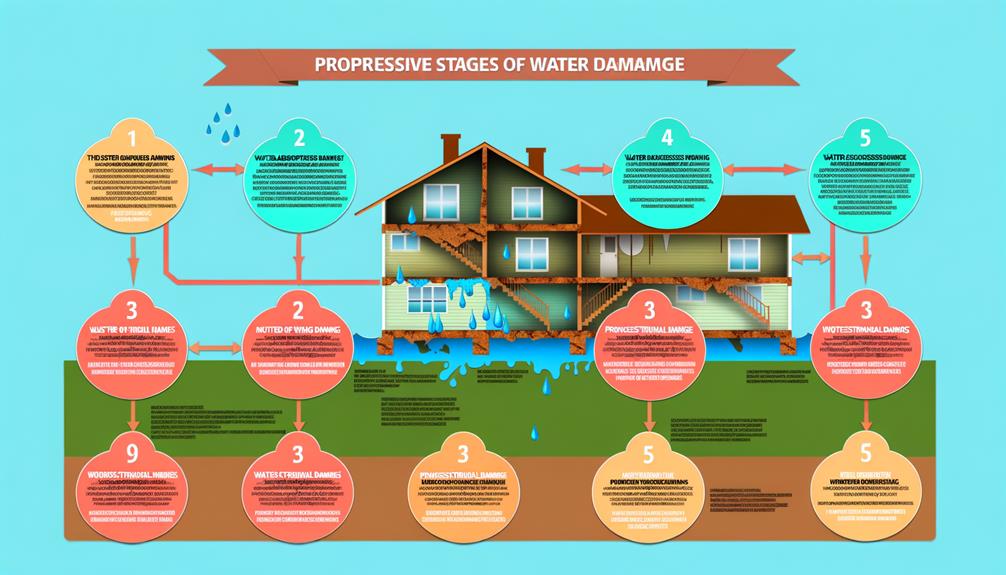
While it may seem straightforward, understanding water damage involves more than just spotting a leak or a flood; it requires a thorough grasp of its causes, impacts, and the signs that may indicate potential problems. You need to be aware of the various damage types, from structural decay to the growth of harmful molds, each having unique implications for your property's safety and value.
Recognizing early warning signs is vital. These may include water stains on walls or ceilings, a musty smell, or unexplained increases in your water bill. Early detection can prevent more severe damage and save you significant repair costs.
Prevention techniques are your best defense against water damage. Regularly inspect your property for any signs of leakage or dampness, especially in susceptible areas like the basement or bathroom. Keep your gutters clean and guarantee your property has good drainage. Install a water alarm to alert you of potential leaks, and consider investing in a dehumidifier for areas with high moisture levels.
Common Causes in East Point
In East Point, you're likely to encounter a variety of typical reasons for water damage, including severe weather conditions, faulty plumbing systems, and even poorly installed roofing.
Roof leaks, for example, are a primary cause of water damage in East Point homes. If your roofing is incorrectly installed or old, it may fail to keep out heavy rain or snow, leading to water seeping into your attic and, eventually, other parts of your home. Over time, this can result in significant structural damage and mold growth.
Burst pipes are another prevalent issue. During the winter, water in your pipes can freeze and expand, causing a pipe to burst. This can lead to substantial water damage, especially if the pipe is within a wall or ceiling. Plumbing systems can also deteriorate because of age, wear and tear, or inadequate installation, resulting in leaks that may remain unnoticed until substantial damage has already occurred.
While these reasons are common, it's important to note that each home is unique, and additional factors can also contribute to water damage. By recognizing these risks, you're better prepared to take measures to safeguard your home.
Preemptive Measures for Prevention
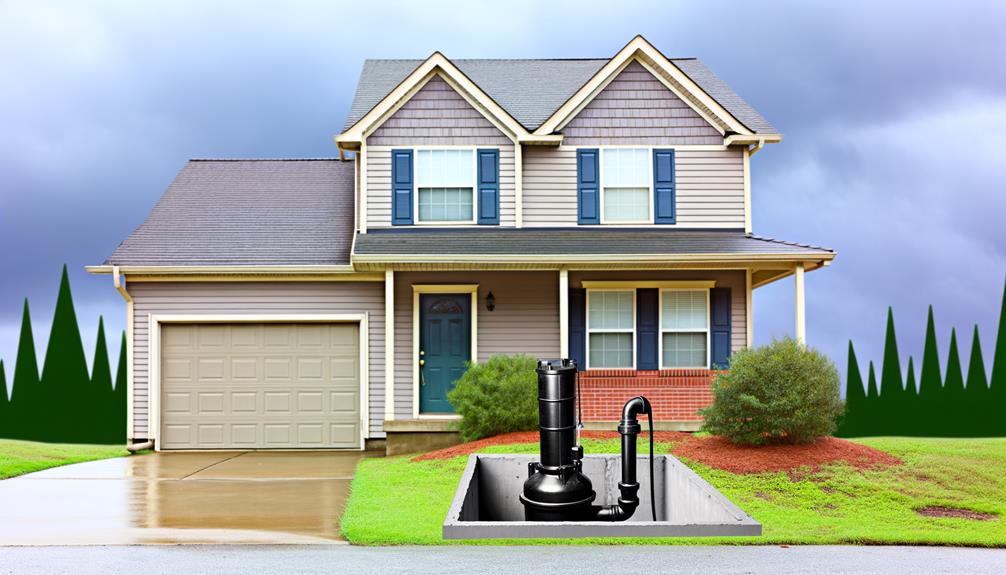
To prevent water damage, it's essential that you take preemptive measures. Regular home inspections are a potent tool, enabling you to detect and address potential problems before they escalate. Moreover, implementing effective drainage solutions can greatly reduce the risk of water damage, safeguarding your property from potential threats.
Regular Home Inspections
Carrying out regular home inspections can greatly reduce the likelihood of water damage, as it allows you to spot and address potential issues before they escalate into costly repairs. You can perform these inspections yourself (DIY inspections) or seek professional help. Both options play pivotal roles in preventive maintenance to mitigate potential risks.
- DIY Inspections: You can conduct these by regularly checking areas prone to water damage, such as your roof, basement, windows, and plumbing. Look for signs of leakage, dampness, or mold. Even though it's a cost-effective approach, it's vital to be thorough to not miss any potential problems.
- Professional Help: If you're unsure about conducting inspections yourself or if you suspect an issue that you can't identify, don't hesitate to call in the professionals. They have the expertise and equipment to spot even the most concealed water damage risks.
- Preventive Maintenance: Regularly cleaning your gutters, maintaining your plumbing system, and ensuring your home's overall good condition can go a long way in preventing water damage.
Effective Drainage Solutions
Ever considered how effective drainage solutions can serve as a strong defense against water damage to your home? It's true. Having a well-planned drainage system is key to preventing potential water damage.
Invest in landscaping solutions that focus on property grading. This involves sloping the land away from your home to direct runoff water safely away from your foundation. It's a natural defense method that's both cost-effective and environmentally friendly.
Waterproofing options also play a vital role. Waterproofing your basement, for instance, provides an added layer of foundation protection. It blocks moisture that could seep into your home, causing substantial damage over time. There are several methods of waterproofing, such as interior sealants, exterior waterproofing, and drainage systems. Each method has its benefits and costs, so it's essential to consult with a professional to determine the most suitable solution for your home.
Recognizing Early Signs
Spotting the early signs of water damage can save you significant time, money, and stress down the line. Early detection is essential in preventing further issues. Here, we'll examine the warning signs to look out for, ensuring your safety and the longevity of your property.
- Discoloration: Water stains on your ceilings or walls are a clear indication of ongoing water damage. They often appear as yellowish or brownish patches.
- Unpleasant Smell: A persistent musty or moldy odor is a telltale sign of hidden water damage. If you can't locate the source of the smell, it's time to investigate more deeply.
- Mold Growth: Visible mold on walls, ceilings, or floors is an undeniable sign of moisture issues. Mold thrives in damp environments and can pose a significant health risk.
Emergency Response Tips
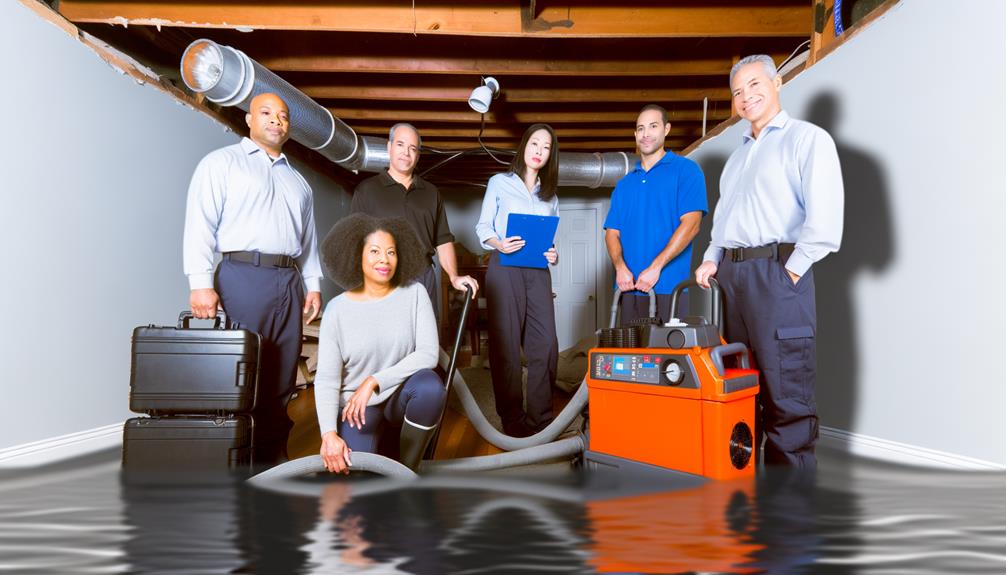
Once you've identified signs of water damage in your property, it's essential that you take immediate and effective action to mitigate the damage and safeguard your home. Crafting an emergency response plan is your first line of defense. This plan should outline the steps you need to take in case of water intrusion, such as shutting off the water source, if possible, and contacting professionals for water damage cleanup.
However, there are quick fixes you can implement to temporarily control the situation. Covering the damaged area with waterproof tarps or using sandbags to prevent further water intrusion can be helpful. Remember, these are interim solutions until professionals arrive.
Swift action is vital in the restoration process, as it can limit the extent of the damage, salvage your belongings, and greatly reduce the costs associated with repairs. Always make sure that you prioritize safety during this process. Avoid entering areas with standing water because of the risk of electrical shock. Wear proper protective equipment like gloves, boots, and a mask if you need to handle water-damaged items.
These emergency response tips can help you manage the initial stages of water damage, but professional intervention is ultimately necessary for thorough cleanup and restoration.
Professional Assessment and Repair
When dealing with water damage, it's important that you enlist the help of professionals for a thorough assessment and repair. Relying on expert assessment can save you time, money, and unnecessary stress. Professionals in the field of water damage restoration not only have the experience but also the necessary tools to conduct an in-depth analysis of the situation.
The process typically involves three key steps:
- Inspection: Experts utilize advanced tools to identify the extent and type of water damage.
- Assessment: After the inspection, they devise a detailed plan, outlining the repair techniques needed.
- Restoration: Using the formulated plan, they carry out necessary repairs and restoration services.
The professionals are well-versed in different repair techniques, ensuring that every bit of water damage is addressed. They can identify hidden issues that might escalate if not dealt with promptly. Moreover, they follow safety standards, providing you with peace of mind during a stressful time.
Safeguarding Your Home's Structure
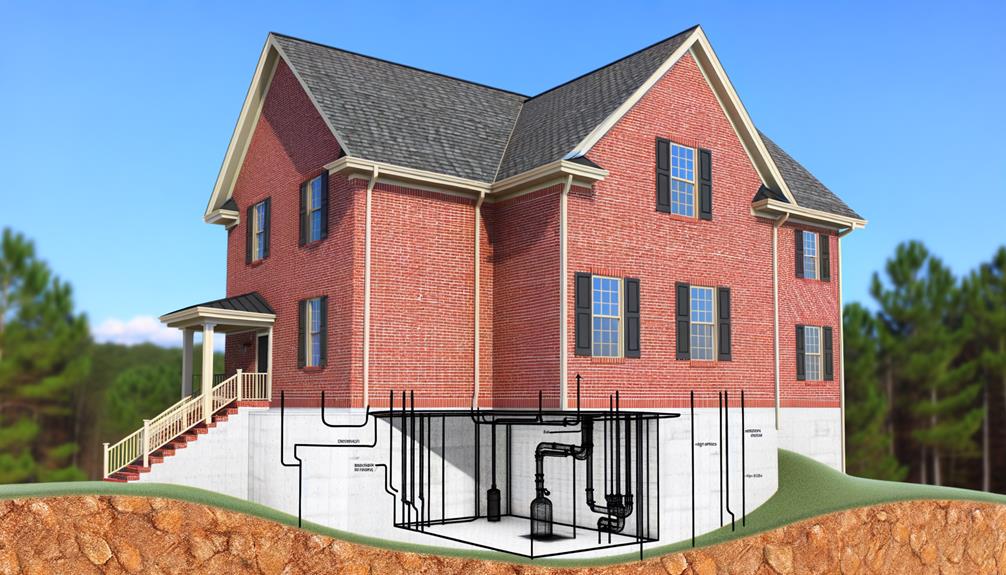
Protecting your home's structure from water damage is essential to maintaining its integrity and value. It's vital to understand the potential vulnerabilities in your home structure to devise an effective prevention strategy against water damage. Moreover, being knowledgeable about the best methods for repairing the impact of water damage can save you significant time, effort, and money in the long run.
Understanding Home Structure Vulnerabilities
To effectively safeguard your home from water damage, it's necessary to first comprehend the vulnerabilities in your home's structure that can potentially result in such issues. Let's explore two key areas where water damage commonly occurs: foundation cracks and roof leaks.
- Foundation Cracks & Moisture Infiltration: Foundation cracks can develop due to soil movement, substandard construction, or simply aging. Moisture can seep into these cracks, leading to water damage and even potentially serious structural issues. Regularly examining your foundation and addressing any cracks promptly is vital.
- Roof Leaks & Structural Damage: Roof leaks are another frequent source of water damage. If left unattended, they could result in significant structural harm. Routine roof maintenance and inspections can help you identify potential problems before they escalate.
- Plumbing System: Don't overlook your plumbing system. Corroded pipes, insecure connections, or faulty fixtures can lead to leaks that cause water damage over time. Regular plumbing checks can help you detect and resolve these issues early.
Understanding these vulnerabilities in your home's structure is the initial step towards prevention. By being proactive, you're not just protecting your home, but also ensuring the safety of your loved ones.
Effective Water Damage Prevention
Now that you understand your home's structural vulnerabilities, let's explore effective strategies for preventing water damage and keeping your home safe. Waterproofing solutions play a significant role in safeguarding your house's structure. These can be either DIY or professionally implemented, depending on your comfort level and the severity of the threat.
Seasonal maintenance is another critical task to undertake. As seasons change, so do the potential sources of water damage. Regular maintenance helps identify and mitigate these risks early.
To help you remember these actions and when to perform them, here's a useful table:
| Season | Task | DIY or Professional |
|---|---|---|
| Spring | Check and clean gutters | DIY |
| Summer | Inspect roof for damage | Professional |
| Fall | Waterproof basements and crawl spaces | Professional |
| Winter | Insulate pipes to prevent freezing | DIY |
| Year-round | Regularly check for leaks | DIY |
Repairing Water Damage Impact
Even with the best prevention strategies in place, you might find yourself dealing with the aftermath of water damage in your home. Safeguarding your home's structure becomes vital when restoring property. Here's where you can start:
- Assess the Damage: Do a thorough assessment of the extent and type of damage. This information is pivotal for determining the necessary repairs and mitigating costs.
- Seek Professional Help: It's essential to engage professionals with experience in water damage restoration. They possess the necessary skills and equipment to safely and effectively restore your property.
- Begin the Restoration Process: This could involve drying out, cleaning, decontaminating, repairing, or even reconstructing parts of your home.
Insurance Coverage Essentials
Understanding your insurance policy's coverage for water damage is vital in safeguarding your home and making sure you're adequately covered for potential losses. It's crucial to be aware of your coverage limits and deductible costs, as these could significantly impact your out-of-pocket expenses following a water damage incident.
Policy exclusions are another essential aspect to grasp. These are specific conditions or events that your policy won't cover. Many policies exclude damage caused by continuous or repeated seepage, which is seen as a maintenance issue rather than an accidental event.
Your deductible is the amount you'll pay out-of-pocket before your insurance kicks in. It's important to budget for this expense and understand how it can affect your claim process.
Speaking of the claim process, it's often a multi-step procedure that requires timely reporting, documentation of damage, and sometimes an inspection by an insurance adjuster. It can be a challenging task, but understanding and managing this process effectively can ensure you receive the compensation you're entitled to.
Long-Term Damage Mitigation Strategies
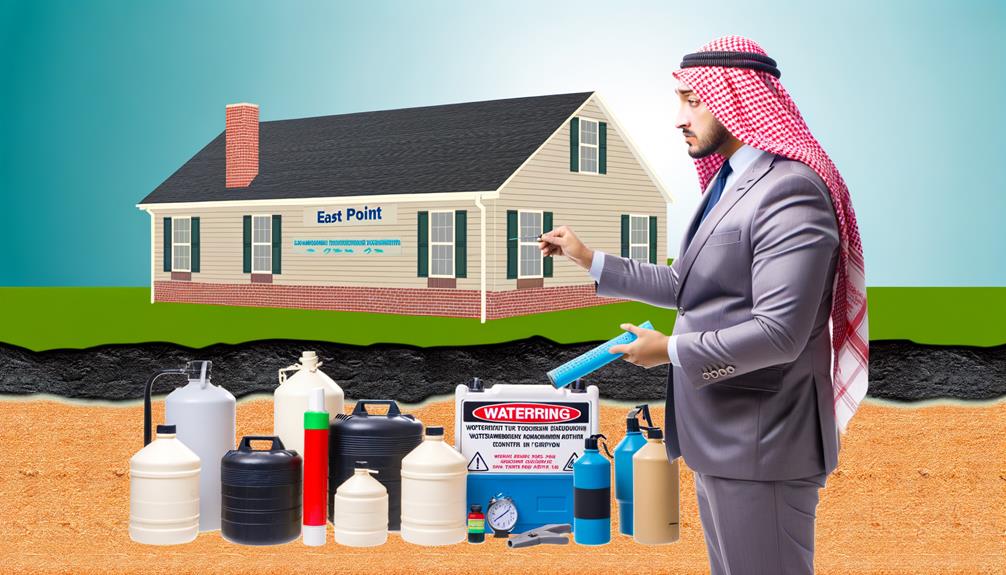
To protect your home from the devastating effects of water damage, it's essential to implement long-term damage mitigation strategies. These strategies not only preserve your home's structural integrity but also reduce potential repair costs. Remember, good property maintenance is your first line of defense against water damage.
- Regular Inspections: Periodically check your home for signs of leaks, dampness, or mold. Pay attention to basements, attics, and bathrooms – areas prone to water damage. Regular inspections help detect issues early, allowing for timely repairs.
- Risk Assessment: Understand the vulnerability of your property to water damage. If you're in a flood-prone area, consider investing in flood barriers or raising electrical systems off the floor. Similarly, if your area experiences heavy rainfall, make sure your gutters and downspouts are clear and functioning properly.
- Maintenance of Plumbing Systems: Aging and poorly maintained plumbing systems are common causes of water damage. Regularly maintain your pipes, faucets, and water heaters to prevent leaks.
These strategies might seem laborious, but they are vital in maintaining a safe and damage-free home. The key is being proactive, rather than reactive, when dealing with potential water damage. After all, prevention is always superior to treatment.
Conclusion
In preventing water damage, you're safeguarding your home's structure and financial well-being. It's not just about immediate repairs, but long-term mitigation strategies and understanding insurance coverage necessities. So, East Point residents, keep an eye out for early signs, respond swiftly and employ professional assessment when necessary. It's about juxtaposing your vigilant prevention measures with an emergency-ready mindset. Remember, your home is not merely a structure, but a haven – and it deserves your utmost care.
